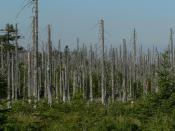Acid rain, more correctly, acid precipitation, is the rain, snow, fog, hail, mist etc. that has a pH level below 5.6, the average acidity of rain. There are many factors which contribute to the acidity, some occurring naturally and others which are produced by industrial activity. Since it can be carried many hundreds of kilometres by winds, acid pollutants emitted in one country may be deposited as acid rain in other countries which makes the problem very hard to contain. Acid rain can have terrible effects on the environment by damaging forests and crops or by lowering the pH of the lakes and rivers, making the water too acidic for many aquatic plants and animals to live. It is also responsible for damage to statues and buildings.
The normal acidity of unpolluted rainwater is caused by the natural presence of carbon dioxide (CO2), found in the troposphere (the lowest layer of the atmosphere).
The existence of CO2 is caused by decomposition of organic materials. It makes the rain slightly acid because the CO2 dissolves in water to form carbonic acid. Rain can also become acetic from volcanic eruptions and forests fires, even reactions that happen between nitrogen and oxygen in lightning storms.
Reactions Between Carbon Dioxide and Water:
(Equations from: )
The occurrence of unnaturally acidic rain is caused by the release of oxides of nitric oxide (NO) and sulfur dioxide (SO2) which when combined with the moisture in the air, may fall as rain with the acidity of sulfuric or nitric acids. About one-fourth of the acidity of rain is accounted for by nitric acid (HNO3). In addition to the natural processes that form small amounts of nitric acid in rainwater, any combustion or burning process will produce NO gas. The main sources of emissions of nitrogen oxides,


